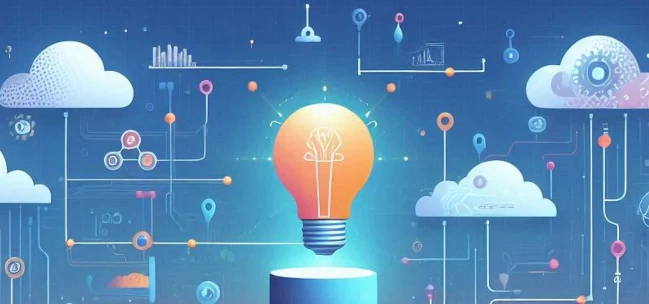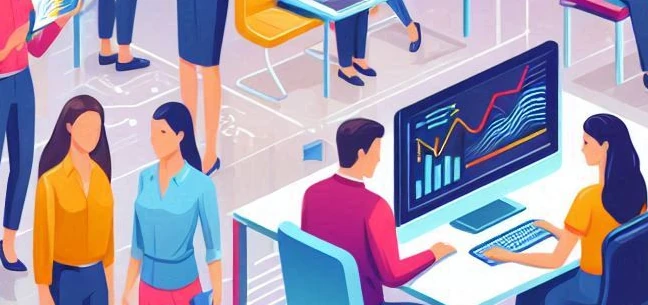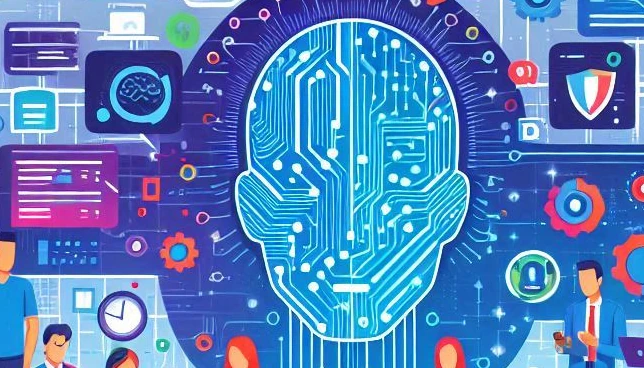OpenAI Canvas - Revolutionizing Human-AI Collaboration in Writing and Coding
AI-assisted writing and coding just got a major upgrade. It's particularly exciting to share our thoughts on OpenAI's latest innovative release on October 3rd, 2024, Canvas.
Their latest feature is a big step forward regarding how users interact with ChatGPT. We believe it will revolutionize the way users collaborate with AI on complex writing & coding projects.

Following The Evolution of AI Interaction
When OpenAI first launched ChatGPT, their goal was to create an accessible interface for interacting with advanced language models. The chat format proved incredibly intuitive, allowing millions of users to engage with AI in ways they never had before. However, as the user base grew and use cases expanded, they recognized the limitations of the linear chat paradigm, especially for more complex, multi-step tasks.Canvas is their response to these challenges. As a complete re-envisioning of how humans and AI can work together, it's more than just an incremental improvement.
Canvas' Key Features and Innovations
OpenAI Canvas represents a quantum leap in how users interact with AI for complex writing and coding tasks. This groundbreaking feature introduces a suite of powerful tools designed to enhance productivity, streamline workflows, and foster seamless collaboration between humans and AI. By addressing common pain points in AI-assisted work, Canvas sets a new standard for intelligent digital workspaces. The following key features demonstrate how Canvas is poised to transform the landscape of AI-powered creativity and problem-solving.Dedicated Workspace
Canvas opens up alongside the regular chat window, providing a dedicated space for tackling complex projects. This dual-pane approach allows users to maintain context while having the freedom to edit and refine AI-generated content directly.
Intuitive Editing
One of Canvas's most powerful features is the ability to highlight specific sections for AI-assisted editing. This granular control addresses a common frustration with chatbots - their difficulty in handling large, multi-step tasks. Now, users can refine AI-generated content without starting from scratch, making the creative process much smoother.
Specialized Tools
They've included shortcuts for frequently used actions to boost productivity. Writers will find tools to request edits, adjust text length, and add final polish to their work. For coders, they've implemented features like code review, bug fixing, and the ability to port code to different languages.

Technical Advancements
Behind the scenes, Canvas represents a significant leap in our AI capabilities. OpenAI trained their GPT-4 model to act more like a collaborative partner, focusing on:OpenAI's research team developed core behaviors including generating diverse content types, making targeted edits, rewriting documents, and providing inline critique. OpenAI used novel synthetic data generation techniques, such as distilling outputs from the o1-preview model, to post-train the model without relying on human-generated data.
Competitive Landscape
Canvas puts OpenAI at the forefront of AI-assisted productivity tools. While companies like Anthropic have introduced similar concepts with Claude Artifacts, OpenAI's implementation offers unique advantages. The fully editable sidebar in Canvas allows for a more fluid collaboration between human and AI, setting a new standard in the industry.
Impact on OpenAI's Strategy
Canvas is more than just a new feature - it's a strategic move that solidifies ChatGPT's position as the leading destination chatbot. By integrating document and code editing capabilities directly into ChatGPT, they're expanding its utility and making it an indispensable tool for a wide range of professionals. This release also their at our broader vision for the future of AI-human collaboration. OpenAI's not just building a chatbot; they're laying the groundwork for a new operating system for the AI age.User Adoption and Rollout
OpenAI's strategy for introducing Canvas is deliberate and carefully planned, designed to ensure they deliver the best possible experience to their users while continuously improving the product. Their is incredible potential for its adoption across various user groups.They've started by making Canvas available to ChatGPT Plus and Teams users. These early adopters are often our most engaged users, and their feedback is invaluable in helping us refine and enhance the Canvas experience. Their insights will shape the future of this tool, ensuring it meets the diverse needs of our user base.
Next week, they'll be extending access to Enterprise and Education users. This is a crucial step in their rollout strategy. Enterprise users will help them understand how Canvas can transform workflows in professional settings, while educators and students will provide unique perspectives on its potential in academic environments. There's particular excitement to see how Canvas might revolutionize collaborative learning and research processes.
This phased approach allows them to gather a wide range of feedback and use cases. OpenAI is not just launching a product; they're initiating a dialogue with their users about the future of human-AI collaboration. Every piece of feedback, every novel use case, helps them refine Canvas to make it even more powerful.

Use-Cases, Insights, and Perspectives
Looking at the early adoption data and user feedback, they're seeing some fascinating trends. Writers are using Canvas to break through creative blocks, experimenting with different narrative structures and writing styles in ways they never could before. Coders are leveraging the tool to tackle complex debugging tasks and explore new programming paradigms. Researchers are using Canvas to synthesize vast amounts of information and generate novel hypotheses.One very exciting use case observed is in cross-functional teams. Canvas is serving as a bridge between technical and non-technical team members, facilitating more effective communication and collaboration. For instance, product managers are using Canvas to work alongside developers, iterating on product specifications and user stories in real-time.
As OpenAI looks towards making Canvas available to all users, including those on the free tier, they're focusing on scalability and accessibility. They want to ensure that Canvas can handle the increased load while maintaining its performance and reliability. They're also working on making the interface as intuitive as possible, so that even users new to AI tools can harness its full potential.
The insights gained from this rollout are invaluable not just for Canvas, but for the future of AI development at OpenAI. Their team is learning so much about how people want to interact with AI, the types of tasks they find most valuable, and the areas where AI can truly augment human creativity and productivity.
Canvas represents a significant step towards our vision of AI as a collaborative partner, seamlessly integrated into our daily work and creative processes. As they continue to refine and expand its capabilities, we believe Canvas will play a crucial role in democratizing access to advanced AI tools, empowering people across all walks of life to achieve more than they ever thought possible.
The journey of Canvas is just beginning, and we couldn't be more excited about the potential it holds. OpenAI is shaping the future of human-AI collaboration, and every user who adopts Canvas is part of this incredible journey.
Impact on Education and Research
Canvas has the potential to revolutionize education and academic research by providing a collaborative workspace where students and researchers can interact with AI in real-time, opening up new possibilities for personalized learning and accelerated discovery across various disciplines. For educators, Canvas enables the creation of adaptive learning materials tailored to individual student needs. The AI can generate customized explanations of complex concepts using language and examples that resonate with each student's background and learning style. Additionally, it can create adaptive practice problems that automatically adjust in difficulty based on a student's performance, ensuring an optimal challenge for growth. Real-time feedback allows students to receive immediate, constructive insights on their work, facilitating rapid iteration and improvement. Furthermore, the AI can present information in various formats—text, diagrams, simulations—catering to different learning preferences.For researchers, Canvas serves as an intelligent assistant that can significantly speed up the research process. It can quickly summarize and synthesize large volumes of academic papers, helping researchers identify key trends and gaps in their field. By analyzing patterns in existing data, the AI can suggest novel hypotheses for exploration and assist in processing complex datasets, potentially uncovering insights that might be overlooked by human researchers alone. Moreover, Canvas can aid in drafting and refining grant proposals, ensuring they are well-structured and aligned with funding agency requirements.
Canvas also facilitates new forms of collaboration in educational settings. The AI can guide and moderate online discussions, ensuring they remain on-topic while encouraging participation from all students. It can assist in project management for group assignments by helping to allocate tasks and providing necessary resources. Additionally, it enhances peer review processes by offering suggestions to improve the quality of feedback, thereby helping students develop critical evaluation skills.
Importantly, Canvas has the potential to make education more accessible and inclusive. Its real-time translation and language adaptation features can support non-native speakers or international students in fully engaging with course materials. The AI can automatically generate alternative formats of content—such as audio descriptions or simplified text—to accommodate students with various disabilities. With round-the-clock assistance available, Canvas provides support outside traditional office hours, making it easier for all learners to access the help they need. By integrating these features, Canvas is poised to transform the educational landscape, making learning more personalized, efficient, and accessible while accelerating the pace of academic research and discovery.

Implications for Creative Industries
This tool represents a significant leap forward in how artists, writers, and designers can collaborate with AI to push the boundaries of their craft. Canvas isn't just a tool; it's a creative partner that can help overcome creative blocks, spark new ideas, and refine work with unprecedented efficiency.In the realm of storytelling, Canvas opens up fascinating possibilities. Imagine screenwriters and novelists using AI to explore complex narrative structures, generate unexpected plot twists, or develop nuanced character arcs. This isn't about replacing human creativity, but rather augmenting it - allowing creators to rapidly iterate on ideas and explore narrative paths they might not have considered otherwise.
Looking ahead, there's particular excitement about expanding Canvas's capabilities into the visual arts. While the initial focus has been on text and code, we can envision a future where designers can use Canvas to generate mood boards, experiment with layouts, or even translate textual concepts into visual designs. This could revolutionize the ideation process in fields like graphic design, architecture, and product design.
Ultimately, the goal with Canvas is to empower creatives, not replace them. They believe that by providing this powerful AI assistant, OpenAI can help unlock new levels of human creativity and innovation across the entire spectrum of creative industries.
Business Applications
Imagine a world where business leaders can engage in real-time, AI-assisted brainstorming sessions that draw upon vast amounts of market data and industry trends. With Canvas, OpenAI is making this a reality. CEOs and strategy teams can now rapidly iterate on business plans, with the AI providing instant feedback and data-driven insights that would typically take weeks of research to compile. This level of agility in strategic planning could be a game-changer, especially for startups and companies in fast-moving industries.But what is truly exciting is how Canvas is poised to revolutionize product development. Product teams are using it to generate user stories, draft technical specifications, and even prototype new features - all with the guidance of an AI that understands both user needs and technical constraints. This isn't about replacing human creativity; it's about amplifying it. By handling many of the time-consuming aspects of product development, Canvas frees up our brightest minds to focus on innovation and solving complex problems.
The potential here is enormous. We're not just talking about incremental improvements in efficiency; we're looking at a completely new approach to how businesses operate and innovate. As there's continued to refinement and expansion Canvas's capabilities, we believe we'll see entirely new business models and products emerge that simply wouldn't have been possible before. This is the kind of transformative technology that has the power to drive economic growth and push the boundaries of what's possible in the business world.

Multilingual and Cross-Cultural Applications
At OpenAI, they have always believed in the power of AI to break down barriers and foster global understanding. With Canvas, they're taking a significant step towards realizing that vision.Canvas isn't just a translation tool; it's a bridge between cultures. The real-time translation and localization capabilities mean that a team in New York can seamlessly collaborate with partners in Tokyo, Paris, or São Paulo, each communicating in their native language. But they've gone beyond mere word-for-word translation. Canvas understands context, nuance, and cultural subtleties, ensuring that the true meaning and intent of communication are preserved across languages.
Canvas's potential to promote cultural sensitivity on a global scale is massive. In today's interconnected world, avoiding cultural missteps is crucial for businesses and individuals alike. Canvas acts as a cultural advisor, flagging potential issues and suggesting more appropriate alternatives. This isn't about censorship; it's about fostering respect and understanding across diverse cultures. Envision a world where international negotiations, global education initiatives, and cross-cultural artistic collaborations are all enhanced by AI that understands and respects cultural nuances.
As the team continues to refine and expand Canvas, we see it becoming an indispensable tool for anyone working in a global context. Whether you're a multinational corporation coordinating across continents or an individual reaching out to a new culture for the first time, Canvas will be there to facilitate clear, respectful, and meaningful communication. This is the kind of transformative technology that can truly bring the world closer together, and couldn't be more excited about the possibilities it opens up for global understanding and collaboration.
Accessibility and Inclusivity
From the very beginning, OpenAI set out to create a tool that could empower everyone, regardless of their abilities or technical background. This isn't just about ticking boxes for accessibility compliance; it's about fundamentally reimagining how AI can enhance human potential across the board.The team put a tremendous amount of effort into integrating Canvas with a wide range of assistive technologies. Whether you're using screen readers, voice commands, or other adaptive tools, they want Canvas to work seamlessly with your preferred method of interaction. Their team has been collaborating with accessibility experts and users with diverse needs to ensure that the power of AI-assisted writing and coding is truly available to all.
At the same time, they recognize that not everyone is a tech enthusiast or power user. That's why they've developed simplified interface options that maintain the full capabilities of Canvas while reducing its complexity. We believe that advanced AI tools should be accessible to everyone, from seasoned developers to first-time users. This approach not only makes Canvas more inclusive but also opens up new possibilities for creativity and innovation from a broader range of perspectives.
Ultimately, the goal with Canvas is to level the playing field and unlock human potential in ways we've never seen before. By making AI assistance truly accessible and inclusive, OpenAI has not just built a product; they're fostering a more equitable future where everyone has the opportunity to contribute their unique ideas and talents. This is the kind of transformative technology that can change lives, and we couldn't be more excited about the impact it will have.

Data Privacy and Security
Data privacy and security are at the core of everything done at OpenAI, and Canvas is no exception. They understand that when you're using AI to assist with writing and coding projects, you're often dealing with sensitive or proprietary information. That's why they've built Canvas from the ground up with privacy and security as top priorities.They've implemented end-to-end encryption for all data in Canvas, ensuring that your information is protected both in transit and at rest. This means that whether you're brainstorming a new business strategy or working on cutting-edge code, you can trust that your data is secure. But they didn't stop there. They believe that true data privacy means giving users control over their own information. That's why they've built granular controls into Canvas that allow you to decide exactly how your data is used and stored.
You have the option to delete or export your data at any time, giving you complete ownership over your work. OpenAI also designed their systems so that the data you input into Canvas is not used to train their models unless you explicitly opt in. This is part of their broader commitment to responsible AI development and respecting user privacy.
OpenAI is constantly evolving their security measures to stay ahead of potential threats. The team works tirelessly to monitor and update our systems, ensuring that Canvas meets the highest standards of data protection. OpenAI also undergoes regular third-party audits to verify their security practices and maintain compliance with global data protection regulations.
At OpenAI, they believe that advanced AI tools like Canvas should empower users without compromising their privacy or security. It's not just about building powerful technology; it's about building trust. With Canvas, theyre're demonstrating that it's possible to push the boundaries of AI while still putting user privacy and security first.
Integration with OpenAI's Ecosystem
Canvas integrates with and enhances OpenAI's broader ecosystem of AI tools and services. Canvas isn't just a standalone feature; it's a crucial piece of their larger strategy to create a comprehensive, AI-powered workspace that revolutionizes how people interact with technology.OpenAI is developing robust APIs that will allow developers to integrate Canvas functionality directly into their own applications. This means the power of Canvas won't be limited to just the ChatGPT interface – it will be available wherever people are working and creating. Imagine your favorite writing app or code editor seamlessly incorporating Canvas's capabilities, providing AI assistance right where you need it most. This API integration is key to their vision of making AI a ubiquitous, helpful presence across all digital workspaces.
But what is really useful is how Canvas synergizes with our other OpenAI products. Their creating a seamless experience where Canvas works in harmony with tools like DALL-E for image generation and Whisper for speech recognition. Picture a workspace where you can draft a document in Canvas, instantly generate relevant images with DALL-E, and transcribe spoken notes using Whisper – all within a unified, AI-powered environment. This level of integration isn't just about convenience; it's about unlocking new levels of creativity and productivity that weren't possible before.
As OpenAI continues to develop and refine these integrations, we believe we're laying the groundwork for a revolution in how people work and create. Canvas, combined with the broader OpenAI ecosystem of AI tools, is paving the way for a future where AI is an intuitive, ever-present collaborator in all our digital endeavors. This is the kind of transformative technology that has the potential to redefine industries and push the boundaries of human creativity and innovation.

Environmental Considerations
Environmental responsibility is a core value at OpenAI, and it's been a key consideration in the development and scaling of Canvas. Recognizing that as AI technologies become more powerful and widespread, their environmental impact grows as well. That's why they've made it a priority to address these concerns head-on with Canvas.OpenAI invested heavily in energy-efficient infrastructure for Canvas, leveraging the latest advancements in green computing. Their data centers are designed to maximize energy efficiency, using state-of-the-art cooling systems and renewable energy sources wherever possible. But they did not stop there. Research teams are constantly exploring ways to optimize their AI models, reducing their computational requirements without sacrificing performance. This isn't just about reducing costs; it's about being responsible stewards of our planet's resources.
Beyond their direct operations, OpenAI is committed to offsetting the carbon emissions associated with Canvas usage. They've partnered with leading environmental organizations to invest in renewable energy projects and large-scale reforestation efforts. These initiatives not only offset their carbon footprint but also contribute to global efforts to combat climate change. OpenAI also exploring innovative carbon capture technologies, looking for ways to not just neutralize our impact, but to potentially make Canvas a net positive for the environment.
As leaders in AI development, there's a responsibility to set the standard for environmental stewardship in the industry. With Canvas, OpenAI is demonstrating that it's possible to push the boundaries of AI technology while also prioritizing sustainability. This isn't just about doing less harm; it's about leveraging their technology to actively contribute to solutions for our planet's environmental challenges. As they continue to scale Canvas, environmental considerations will remain at the forefront of the decision-making process.
Long-Term Vision
Taking a look into the long-term vision for Canvas and how it fits into their broader mission at OpenAI is exciting. Canvas isn't just a product; it's a glimpse into the future of human-AI collaboration, and only scratching the surface of its potential.Looking ahead, we envision Canvas evolving into an even more intuitive and powerful tool that seamlessly integrates with emerging technologies. One area that's particularly intriguing about is the integration of Canvas with augmented reality. Imagine putting on a pair of AR glasses and having your Canvas workspace materialize in front of you, allowing you to manipulate text and code in three-dimensional space with AI assistance at your fingertips. This could revolutionize how we work, blending the digital and physical worlds in ways we've only dreamed of until now.
OpenAI is also exploring predictive assistance capabilities for future versions of Canvas. The goal is to create an AI collaborator that doesn't just respond to your commands, but anticipates your needs and proactively offers suggestions. This could mean Canvas recognizing patterns in your work and automatically suggesting relevant resources, or even starting tasks it predicts you'll need before you ask. Of course, they're approaching this with careful consideration for user privacy and control – the AI should be helpful without being intrusive.
But perhaps what's most exiciting about the long-term vision for Canvas is its potential to democratize access to advanced AI capabilities. As they continue to refine and expand Canvas, they're working towards a future where anyone, regardless of their technical background, can harness the power of AI to augment their creativity and problem-solving abilities. This aligns perfectly with OpenAI's mission to ensure that artificial general intelligence benefits all of humanity.
Canvas is more than just a product – it's a platform for innovation that will evolve alongside advancements in AI technology. As OpenAI pushes the boundaries of what's possible with language models and other AI systems, Canvas will be at the forefront, continuously adapting to offer new and powerful ways for humans and AI to work together. The journey ahead is thrilling, and with much anticipation to see how Canvas will shape the future of work and creativity.

Ethical Considerations
Ethical considerations are at the core of everything done at OpenAI, and Canvas is no exception. They've carefully designed Canvas with robust safeguards to prevent misuse while maximizing its potential to enhance human creativity and productivity.The team has implemented advanced content filtering systems to ensure that Canvas cannot be used to generate harmful or inappropriate content. They've also built in mechanisms to prevent the unauthorized use of copyrighted material, addressing concerns about intellectual property rights.
They're committed to ongoing monitoring and adjustment of Canvas's capabilities. They have a dedicated ethics board that regularly reviews the tool's usage and impact, making recommendations for improvements or restrictions as needed. This iterative approach allows them to stay ahead of potential ethical challenges as they emerge.
Transparency is also a key part of the ethical framework for Canvas. They're providing clear guidelines to users about the tool's capabilities and limitations, ensuring they understand how to use it responsibly. They're also actively engaging with ethicists, policymakers, and other stakeholders to ensure that Canvas aligns with broader societal values and norms.
Impact and Future Potential
Canvas has the potential to revolutionize various fields, making significant strides in education, creative industries, business applications, and cross-cultural communication. In education and research, Canvas enables personalized learning experiences, allowing educators to tailor materials to individual student needs and helping researchers accelerate scientific discovery by summarizing papers and drafting proposals efficiently. The creative sector stands to benefit immensely as well; writers, designers, and artists can overcome creative blocks and explore new ideas through collaborative storytelling and design iterations facilitated by AI.In the business realm, Canvas streamlines strategic planning and product development processes, empowering teams to brainstorm strategies and generate user stories with real-time AI assistance. Furthermore, its capabilities extend to fostering global communication by providing real-time translation and cultural adaptation of content, which is vital for businesses operating in diverse markets. As OpenAI continues to refine and expand Canvas, it is poised to become an indispensable tool for professionals across various industries, setting a new standard for AI-assisted productivity and creativity while paving the way for innovative applications that enhance human potential.
LIked this article? Find more AI and ML news here: ML AI News.
by ML & AI News
6,430 views
Machine Learning Artificial Intelligence News
https://machinelearningartificialintelligence.com
AI & ML



Sign Up for Our Newsletter